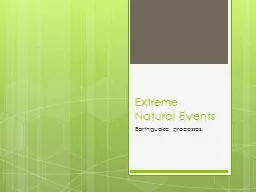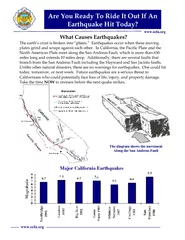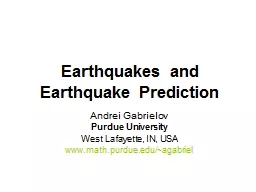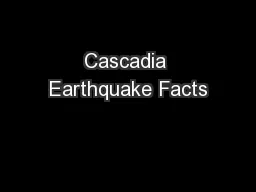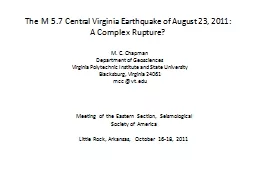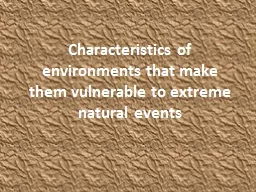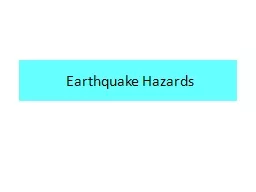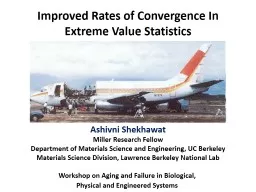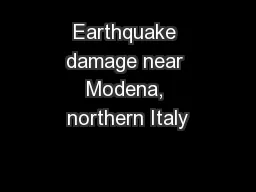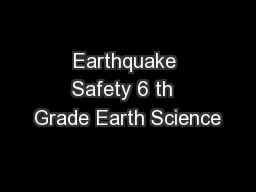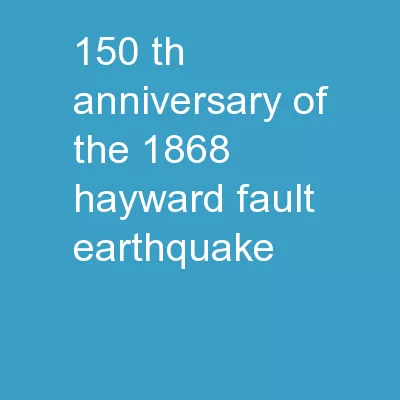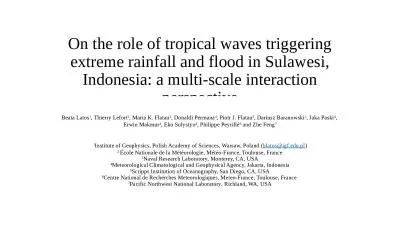PPT-Extreme Natural Events Earthquake processes.
Author : pamella-moone | Published Date : 2018-03-09
Stage 1 Magma rises to the crust within the mantle This creates friction and causes the plates to move What are the 3 main ways plates move 1 2 3 Stage 2 Pressure
Presentation Embed Code
Download Presentation
Download Presentation The PPT/PDF document "Extreme Natural Events Earthquake proces..." is the property of its rightful owner. Permission is granted to download and print the materials on this website for personal, non-commercial use only, and to display it on your personal computer provided you do not modify the materials and that you retain all copyright notices contained in the materials. By downloading content from our website, you accept the terms of this agreement.
Extreme Natural Events Earthquake processes.: Transcript
Stage 1 Magma rises to the crust within the mantle This creates friction and causes the plates to move What are the 3 main ways plates move 1 2 3 Stage 2 Pressure builds between plates and sometimes small earthquakes are felt . Magnitude 8.0 SOLOMON ISLANDS . Wednesday, 6 February, 2013 at 01:12:23 UTC. Australia. Magnitude 8.0 SOLOMON ISLANDS . Wednesday, 6 February, 2013 at 01:12:23 UTC. Tsunami model amplitude information is shown colour-coded to the scale. Filled colours show maximum computed tsunami amplitude in cm during 24 hours of wave propagation. Black contours show computed tsunami arrival time. . Are You Prepared To Ride It Out? We have heard it so many times –the “big one” is coming. In our lifetime, we still haven’t seen or felt that huge earthquake. That shouldn’t stop us from preparing. Andrei Gabrielov. Purdue University. West Lafayette, IN, USA. www.math.purdue.edu/~agabriel. San Francisco, April 18, 1906. Plate Tectonics. Major tectonic plates and world seismicity. Plate Tectonics. :. What You Need To Know. Tsunami Outreach Oregon. Oregon Department of . Geology . and Mineral Industries . Cascadia Earthquake: Key Messages. A local Cascadia earthquake will probably happen in most people’s lifetime or their children’s lifetime.. A Complex Rupture?. M. C. Chapman. Department of Geosciences. Virginia Polytechnic Institute and State University. Blacksburg, Virginia 24061. mcc. @ vt.edu. Meeting of the Eastern Section, Seismological. Hazard . Prediction Based on Seismicity . Simulation. . Shiyong. Zhou Russell Robinson . Xiaofei. Chen . M. Jiang . X. . Jin. . B. Gao . Disasters. By Eric Liu. Natural Disasters. A . natural disaster. is the effect of a natural hazard that affects the environment, and human.. For example: Volcano Tsunami Earthquake . Volcano. Questions to assess vulnerability. + How likely is an extreme natural event and will it affect people?. + How vulnerable are people to natural hazards?. + To what extent are societies able to cope with severe and immediate disasters?. Hazards are produced from the response of energy released. Amount and duration are related to the amount of energy released. Which hazards do you know?. Earthquake Hazards. Tsunami: displacement of a large volume of water. Ashivni Shekhawat. Miller Research Fellow. Department of Materials Science and Engineering, UC Berkeley. Materials Science Division, Lawrence Berkeley National Lab. Workshop on . Aging and Failure in Biological, . Magnitude and Intensity: M. w. 6.0 & 5.8; MMI VI-VII. Date: May 20. th. and 29. th. 2012. Today’s Presentation:. A short lecture activity sequence designed to engage students in learning about EQ epicenter location . Earthquake Risk. Earthquakes are likely wherever plate movement stores energy in the rock along faults.. Geologists can determine earthquake risk by locating where faults are active and where past earthquakes have occurred.. Earthquake Country Alliance. Cisco, San Jose, March 1. , 2018. SAFRR: Science Application for Risk Reduction. SAFRR: Science Application for Risk Reduction …. NATURAL HAZARDS MISSION AREA Earthquake Hazards Program. perspective. Beata . Latos. 1. ,. Thierry . Lefort. 2. , Maria . K. . Flatau. 3. , Donaldi Permana. 4. , Piotr . J. . Flatau. 5. , . Dariusz. . Baranowski. 1. , . Jaka. Paski. 4. , . Erwin Makmur.
Download Document
Here is the link to download the presentation.
"Extreme Natural Events Earthquake processes."The content belongs to its owner. You may download and print it for personal use, without modification, and keep all copyright notices. By downloading, you agree to these terms.
Related Documents

